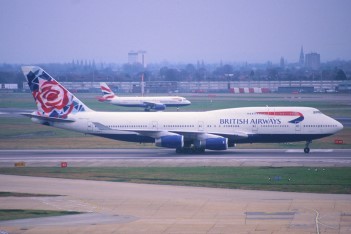The Boeing 747: the plane that gave us the world
01 February 2022

January 1970. The start of a new decade and new horizons - in more ways than one. The Boeing 747 enters service for the first time, ushering a new dawn of aviation technology - the jumbo jet age!
Fast forward over half a century, amid turbulence in the aviation industry, and the glorious 747 only retired from British Airways' fleet in August 2020.
So, to commemorate the cultural significance of the 747, FlyDays.co.uk has decided to take a nosedive into the history of the 'Queen of the Skies'.
Flying For All
In an age of low-cost airlines and improved safety conditions, flying is now an accepted part of life, but this has not always been the case. Before 1970, flying was a privilege enjoyed by the elite and business travellers.
So, when Chief test pilot, Jack Waddell, successfully opened the throttles and hurtled down the runway to soar the 747 into the skies over Washington in February 1969 for its first test flight, little did he know he was at the helm of a plane that would 'shrink the world' for the masses for decades to come.
The increased capacity of the 747 compelled airlines to offer much more competitive fares to fill the whole of the plane, making flying much more affordable for the wider public. In fact, in the past five decades of its service, the global fleet of 747s have flown more than 5.9 billion people - the equivalent of 78% of the world's population.
Size
And the 747 isn't dubbed the Jumbo Jet for no reason! With a wingspan as wide as a football pitch and as tall as a six-story building, the original model carried up to 416 passengers, nearly doubling the capacity of its predecessors. Such was the room the 747 afforded, a Pan Am post card read "the plane with all the room in the world".
The Boeing 747: Key Stats
- Passenger capacity: Up to 416
- Length: 231ft 10in
- Wingspan: 211ft 5in
- Height: 68ft 8in
- Engines: 4 Rolls Royce RB211-524H
- Thrust: Up to 60,600lb each
Design and Creation
Of course, to build a plane of such huge dimensions, the expertise and determination of thousands of professionals was required. Indeed, at the height of the project, some 20,000 Boeing employees, including engineers, mechanics, construction workers and administrators were at work on bringing the 747 to life.
This workforce helped bring about the jet's best features, including the iconic upper deck - known as the hump - that housed the cockpit and a select few passenger seats. Such features earned the 747 acclaim for its creative use of space, so much so, if you asked famed architect Sir Norman Foster what his favourite building is, you'll find that it's not a building at all, but the 747.
In Conclusion
For its sheer size alone, the 747 has astonished generation after generation of aviation geeks and jetsetters alike. But there's also little doubt that the 747's impact on aviation and wider society is as big as its size. So, when you next board a plane, spare a thought for the Queen of the Skies.



